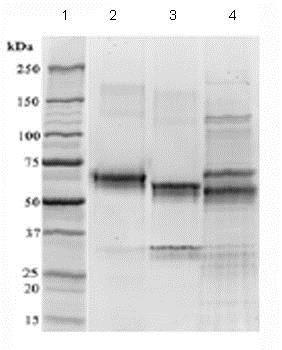Recombinant Human CD134 / OX40L receptor protein (Fc Chimera) (ab83676)
Key features and details
- Expression system: HEK 293 cells
- Purity: > 95% SDS-PAGE
- Suitable for: SDS-PAGE
-
Product name
Recombinant Human CD134 / OX40L receptor protein (Fc Chimera)
See all CD134 / OX40L receptor proteins and peptides -
Purity
> 95 % SDS-PAGE. -
Expression system
HEK 293 cells -
Accession
-
Protein length
Protein fragment -
Animal free
No -
Nature
Recombinant -
-
Species
Human -
Sequence
Theoretical sequence: LHCVGDTYPSNDRCCHECRPGNGMVSRCSRSQNTVCRPC GPGFYNDVVSSKPCKP CTWCNLRSGSERKQLCTATQDTVCRCRAGTQP LDSYKPGVDCAPCPPGHFSPGDNQ ACKPWTNCTLAGKHTLQPASNSSD AICEDRDPPATQPQETQGPPARPITVQPTEAWP RTSQGPSTRPVGIPK VDKKVEPKSCDKTHTCPPCPAPELLGGPSVFLFPPKPKDTLMIS RTPE VTCVVVDVSHEDPEVKFNWYVDGVEVHNAKTKPREEQYNSTYRVVSVLTV LHQ DWLNGKEYKCRVSNKALPAPIEKTISKAKGQPREPQVYTLPPSRD ELTKNQVSLTCLV KGFYPSDIAVEWESNGQPENNYKTTPPVLDSDGSF FLYSKLTVDKSRWQQGNVFSCS VMHEALHNHYTQKSLSLSPGK -
Amino acids
1 to 207 -
Additional sequence information
Fused with the Fc region of Human IgG1 at the C-terminus.
-
Preparation and Storage
-
Stability and Storage
Shipped at 4°C. Upon delivery aliquot and store at -20°C. Avoid freeze / thaw cycles.
Constituents: PBS, 1% Human serum albumin, 10% Trehalose
-
ReconstitutionIt is recommended that 0.5 ml of sterile phosphate-buffered saline be added to the vial.
Images
-
Lane 1 MW markers; Lane 2 ab83676; Lane 3 ab83676 treated with PNGase F to remove potential N-linked glycans; Lane 4 ab83676 treated with a glycosidase cocktail to remove potential N- and O-linked glycans. 10 μg protein loaded per lane; Deep Purple™ stained.
Drop in MW after treatment with PNGase F indicates presence of N-linked glycans. Slight drop in MW after treatment with glycosidase cocktail suggests presence of Olinked glycans. Additional bands in lane 3 and lane 4 are glycosidase enzymes. -
A sample of ab83676 without carrier protein was reduced and alkylated and focused on a 3-10 IPG strip then run on a 4-20% Tris HCl 2D gel. 40 μg protein loaded per lane; Deep Purple™ stained. Spot train indicates presence of multiple isoforms of the Chimera. Spots within the spot train were cut from the gel and identified as the Chimera by protein mass fingerprinting.
-
Post-translational modifications result in protein heterogeneity. The densitometry scan demonstrates the purified ab83676 exists in multiple isoforms, which differ according to their level of post-translational modification. Expression of these isoforms is highly significant for cell biology, as they more closely resemble the native human proteins.
Triangle indicates theoretical pI and MW of the protein.
















